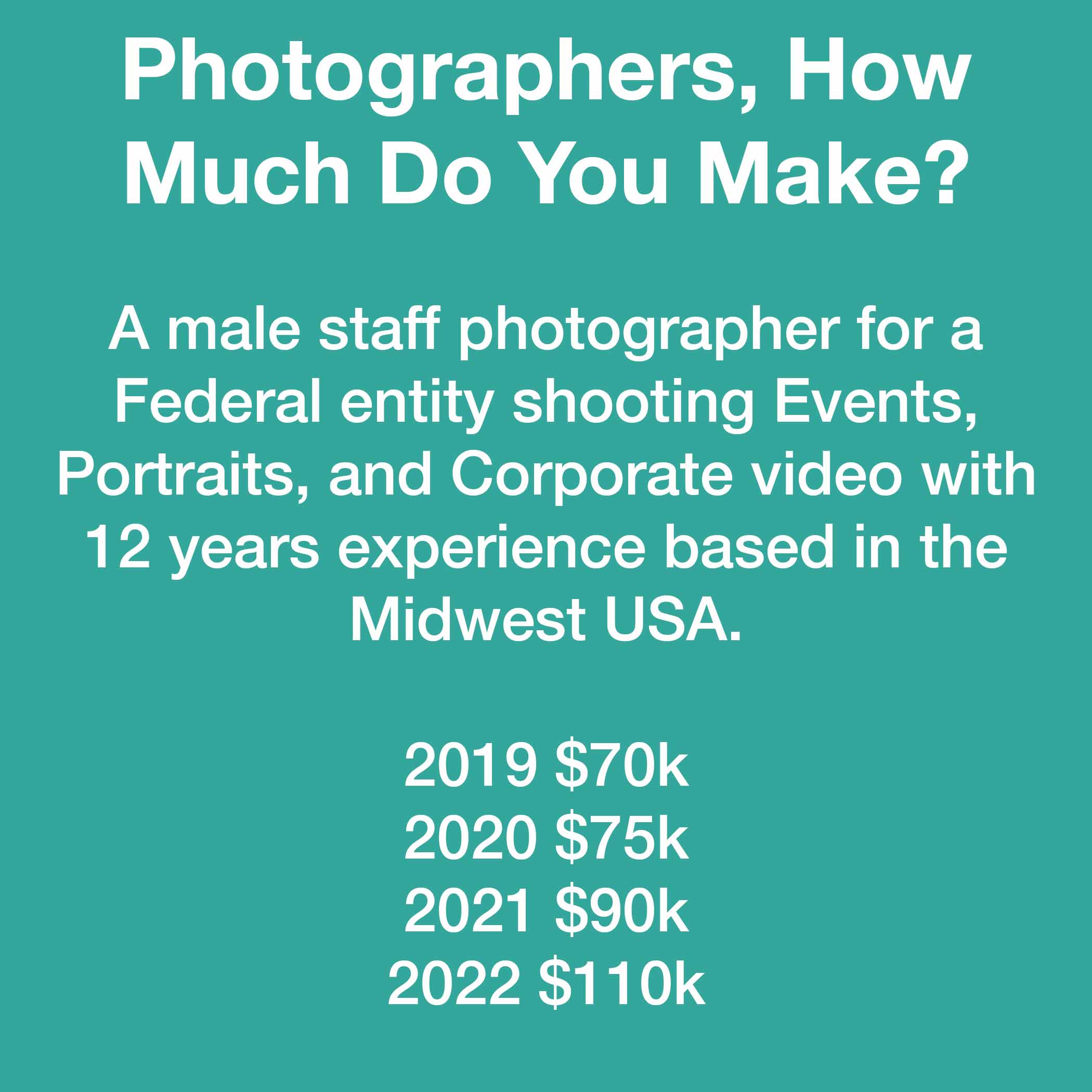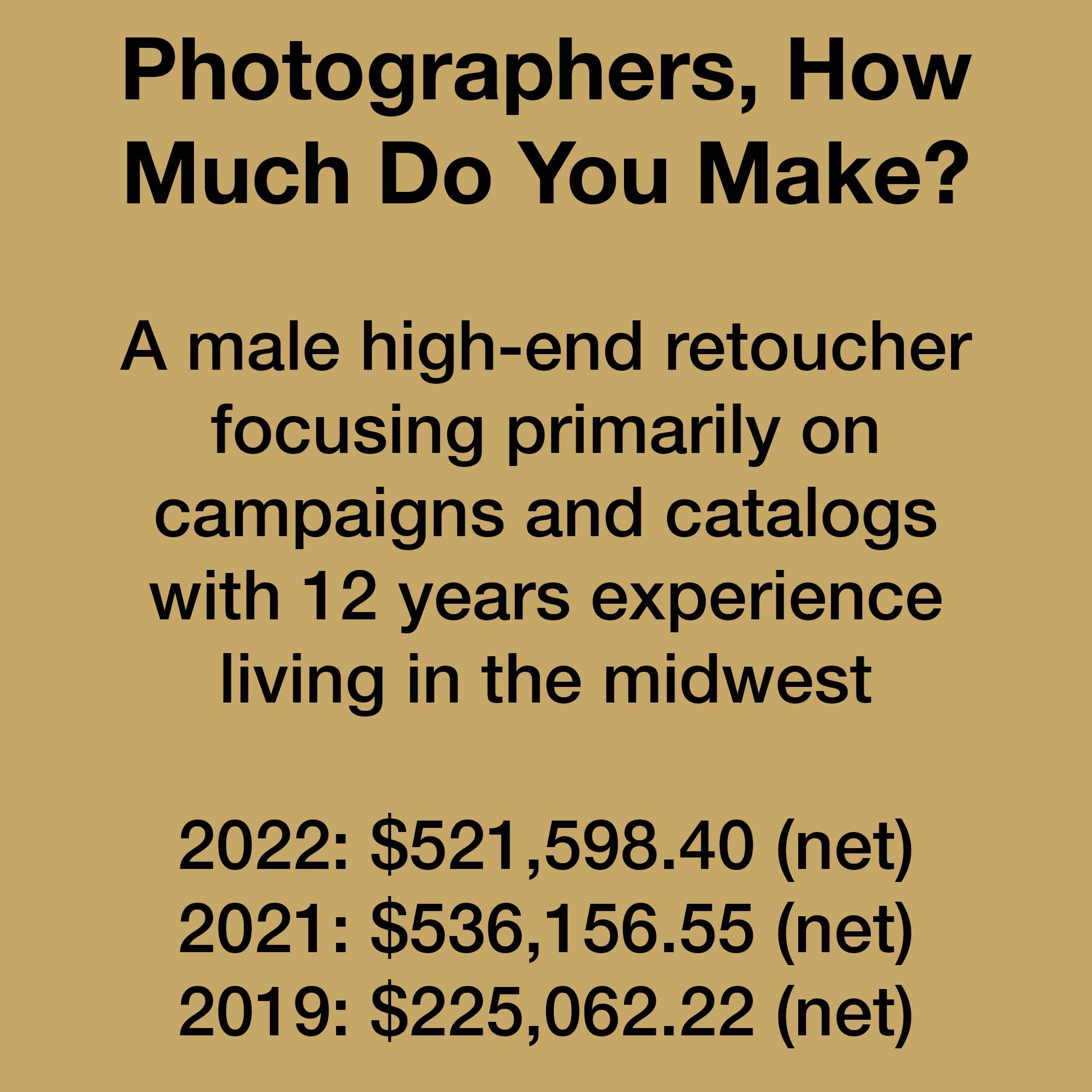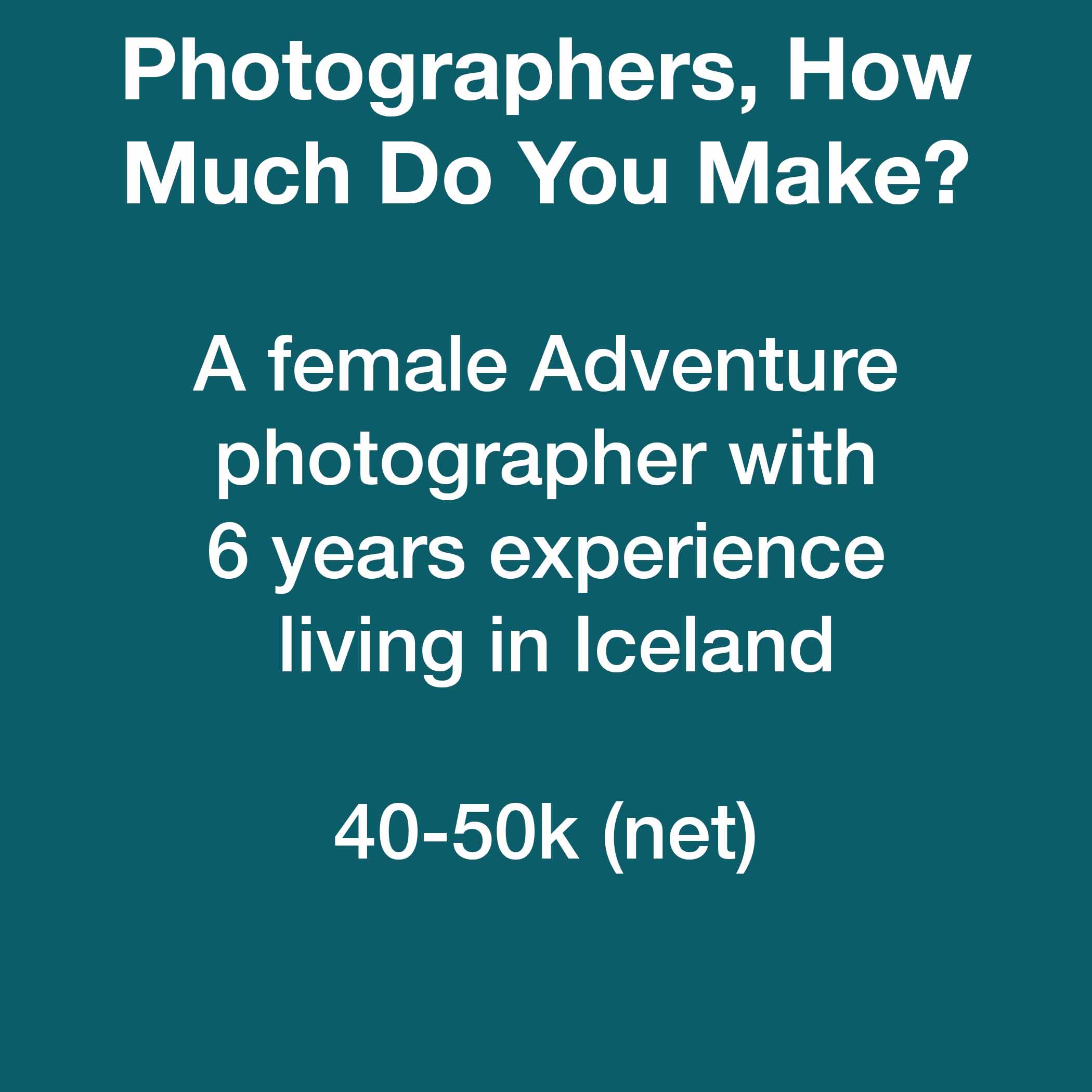Until 2022 I was a staff product photog at an e-commerce/YouTube company. I was also doing more freelance work to supplement my income (events, portraits, commercial, editorial, and food).
My current “clients” are other departments within the organization I work for, which serves the US government and other Federal entities. They require images or video to illustrate their work within sectors serving finance, education, community development, cybersecurity, technology, and commerce. I work 5 days a week and have zero overhead.
I was chronically underpaid at my previous staff job but supplemented it with freelance work that was steady until 2020. I switched employers in late 2021 and have been fairly compensated since, therefore can be choosy about freelance projects.
I’m a gigging musician as well, which adds about $20k to my annual income.
For commercial work, I charge $1600 per 10-hour day + expenses + usage.
My best paying recent shoot was a 3 day commercial shoot for an ag client that was $2500/day, they paid travel and expenses, and I was simply shadowing a film crew and using their lighting setups—dream gig.
My lowest paying recent shoot was dog food with a charitable component: $1200 for a 6-hour day plus another 4 hours of retouching work, plus usage. Client never specified the usage but used the photos, and I had to fight to get paid.
Video is about 35% of my work but growing. I’m salaried, so the percentage correlates.
Work hard. Be nice. The rest tends to take care of itself.
My best year, I made $350,000. That was at the height of my career. During Covid I made about $50,000.
I began photographing dogs in 1996 on black and white film in the studio in San Francisco. I have stuck with photographing only dogs for the past 27 years. I have worked for Hills, Mars and Safeway brand dog food. I have published six books of my dog photography. I have shot for National Geographic, The Bark Magazine and PetPlan Pet Insurance. My style is very simple, photographing dogs against a white background and capturing their personalities and beauty. Currently, I primarily do commission portraits of peoples pets. I charge $1,400 for a portrait session and average about 80 sessions a year.
My portrait sessions are about 80 percent of my income. Print orders and licensing account for the remaining 20 percent of my income.
I work in all the major metros in the United States.
My husband and I run our business together full time. My biggest overhead is travel expenses. I work out of my home.
I work a lot of weekends. I shoot probably two weekends out of the month. Then I have daily work in client relations, promotion, printing and general communication.
My clients are wonderful, dog loving people. They have a true affinity for their dogs and want to memorialize them while they are in the prime of their lives. They are willing to pay for the quality of work that we create.
I did not work much during 2020 and Covid. Then last year (2022) I battled breast cancer and did not work for 9 months. That was really hard and I am just now getting the engines back up and running.
No video work.
I decided to go into a photographic niche early on and it has worked out very well for me. It certainly helped that I have a love and understanding of dogs. Over the years, I have amassed a large image database of dog imagery that I am going to be putting on the market in the near future.
50% of the work is for brand campaigns which include OOH, editorial placements, digital and in-store. 35% is catalog, and 15% is e-commerce.
We have a good mix of larger fortune 500 and international brands. But also have smaller localized clients in NYC, LA, San Fan, and MPLS.
1 full-time employee (retoucher), and we also hire freelance retouchers on a per-project basis as needed.
I used to have offices in both the Midwest and East Coast, but since covid, I have gotten rid of both offices, and we are 100% remote now, working from home. There are great online tools to assist with reviewing images/collecting feedback, and clients are now used to jumping on video calls. Our largest expenses now are payroll, subcontractors, software, and insurance
2023 goal is to maintain our 60% profit margin and average $4000 in billings per working day.
I work 220 days a year 8 hours days. It’s pretty much a 9-5, but of course, some days/weeks are longer if we need to take meetings with clients in other time zones or projects are on a rush schedule. Sometimes we decide to take on extra work because we like the project and we are ok with putting in more time.
For the most part, our clients are very enjoyable, organized, and great to work with! We are very fortunate 🙂. I’d say once or twice a month, we get a project with a new/newer client where we need to “manage up” and help put some guide rails and structure in place to complete projects on time and within budget. Given our schedule is usually very tight, its really important to stay within schedules so there are no time crunches and delays. The majority (I’d say more than 90%) of our clients are from referrals.
2022 and 2021 have been good and steady, took a large hit in 2020 due to covid, most of our larger projects were stalled, canceled, or got pushed out until clients figured out how to move forward in a pandemic.
We estimate on a per-project basis. Even with clients who we have annual rate contracts with, we still estimate because no two shots are ever the same. Our hourly rate ranges from $175 – $250/hour depending on the type of retouching/project, number or assets, number of review rounds, turnaround time, and final asset outputs. We can have anywhere from 3-10 projects going on at any given time, so we keep a very tight and organized schedule. I like to keep our working days to 8 hours, though some will go to 10+ if we need the extra time to meet deadlines.
On an effort-to-pay basis, the best project we had was for a global hotel chain campaign. The client came to us after already working with another retouching studio who was not working out, and they wanted us to take over the project. We didn’t estimate it as they had a set budget of 75K, and the amount of work they needed would definitely fit within this. When all was completed, we averaged ~950/hr.
Our worst-paying and most frustrating jobs have always been editorials, specifically celebrity editorials. Many publications have set editorial budgets, typically paying around $300/image and $800-$1000 for a cover. However, with the amount of work that can go into them, you end up averaging ~$75-$100/hour. Also, they tend to have crazy timelines with no room for rush fees. The only reason we take these is if we think it would be a good portfolio piece or if its a good client of ours who wants us to work on the images.
I think post-production scheduling and organization is greatly overlooked; when done properly, it can save a lot of time, money, and headache. Also, the way in which feedback is communicated to retouchers can have an effect on the outcome of the project. Everything runs smoother when retouchers have the proper time needed and receive organized, detailed feedback and assets!
The worst paying was just working for free to build a portfolio to be able to get paying clients. That was at the beginning. But like I previously mentioned above, my next assignment will pay $5000 for two months of work, but I will be sailing to 4 different continents.
Yes, I shoot video as well. That is part of my take-home as well. In my work, I shoot photos and videos, and at the moment, combined, that is around 40k.
I am a former musician, and since I was a child, my dream was to become an Adventure photographer and travel the world. I quit my music career to pursue photography. I went 110 percent all in. I sold everything I owned, left my place, and hit the road trying to figure it out. I was alone doing it, trying to navigate the world figuring out this new career path. I worked for free at first for a lot of assignments; I lived in shitty places and out of a suitcase. It was really difficult. In 2019 things started to change and look up. I was getting paid for the work I wanted to make, then covid came. During covid, I hustled, and since I lived in a remote village in Iceland, different companies found that interesting, and I was getting work shooting and licensing. Now in present day, more companies are starting to reach out, I barely get by with what I am making, but each year gets better. I think the goal is just don’t give up, progress, and keep going. I’ve raised my price, but unless it’s an absolute project with a low budget that I can’t turn down, then I will do it.
I am a photojournalist and have mostly covered conflict in countries like Afghanistan, Libya, or Iraq. Recently, I decided to only fly in exceptional circumstances. Thus I have reduced my radius significantly and only pitch stories I can reach by train. I did some commercial shoots but have not pursued more, even though it took only a week to make what I normally make in four months. My income is diversified since I do write, shoot video, direct movies, and give workshops and lectures. I do live on a farm and spend significant amounts of time in the fields every year. It keeps me sane.
80 percent of my income is from photojournalism, feature writing, and TV. The rest is workshops, lectures, and sponsorship deals.
My clients are newspapers, magazines, TV stations, and other journalistic outlets.
I keep my overhead low. My accountant is 2,000/year. Otherwise, there is only insurance. I am lucky that I don’t use much gear and get cameras and lenses as part of a sponsorship deal.
I work 160 days a year.
My income has been increasing slightly every year. This year began very good since I had relatively well-paid assignments back to back.
I am privileged since I am from a wealthy family. I don’t rely on them financially, but I know that it is insurance in case I get sick or lose significant parts of my income. It also frees me to some extent to not work for clients I don’t like to work for.
What is important to understand in my case is that living expenses here are significantly lower than in the US. Rent here is probably a third of what you would pay in comparable US cities. Even though I am a freelancer, half of my health insurance and retirement plan is paid through a publicly regulated system. Both together cost me $550/month without any deductibles or co-pays (except for aesthetic dental procedures).
My shoots almost always include long travel under difficult circumstances. In some cases, travel to the location takes three to four days. I normally stay between one week and three weeks. Day rates start at around $450. Travel days are normally paid half. Conflict situations are paid double. What constitutes conflict is sometimes disputed. Do you have to be in a country at war? Do you have to be close to actual combat? Or does it have to be both? This has improved in recent years, though, because of pressure from photographers.
This past week, I made $5,500 net. That included four days of travel to and from the country and three days of shooting. The shooting days also included hours in a 4×4 on bumpy dirt tracks. The client has unlimited usage rights, though I can license images myself as well.
It is hard to say, in my case, what my worst-paying shoot was recently. I do write feature stories as well and sometimes do package deals that include images and text. A few years ago, I did a story that I shot and researched in about ten days. But the written story was legally challenging, went through various editing rounds, and took weeks to finish. I don’t keep track of my hours, but my estimate was that I ended up getting paid minimum wage.
I do shoot video as well and also direct TV features. That has picked up recently. I try to use print stories as recce for potential documentaries.
After reading what commercial photographers in the US can make, it feels like this is a completely different financial world. But I think it is hard to compare.
Even though my profit is comparably low, I am very content with what I make and can live a comfortable life. I only work on projects I stand fully behind. I don’t work for clients with questionable labor or environmental practices. And most importantly, I like what I do.





1 Comment
Interesting – as a photographer living in northern Europe I can only dream of such revenues.
Comments are closed for this article!